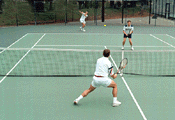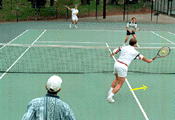<% ns_puts [nsv_get mkm_includes mkm_oldContentHeader_inc] %>
 Lesson
Lesson
Potent Poaching:
Track and Move
By Monty Basnyat,
TennisONE Associate Editor
Strategy Question
I love doubles! The whole idea of coming in as much as
possible and poaching every chance you get excites me. But lately my poaches
have not been very effective and penetrating. I understand the concept of
timing the movement on the poach but is there anything else you can help
me with to make my poaches more potent?
Answer
There are two things you need to understand for a potent
poach.
- Timing the poach.
- Tracking and moving.
Since we have covered concept
#1 in the past lessons, we will concentrate on the second concept.
 Once the poacher has
started his movement for the poach, there are two things that he must learn
to do at the same time: track the ball (#1) while moving (#2). Most novice
poachers tend to concentrate on one thing and that's what hurts them. They
either move and just see a yellow blur of the ball or they move, get as
far as the white line that divides the two service boxes and then try to
react to the ball. The result is they end up looking at their partner and
saying, "Sorry about that."
Once the poacher has
started his movement for the poach, there are two things that he must learn
to do at the same time: track the ball (#1) while moving (#2). Most novice
poachers tend to concentrate on one thing and that's what hurts them. They
either move and just see a yellow blur of the ball or they move, get as
far as the white line that divides the two service boxes and then try to
react to the ball. The result is they end up looking at their partner and
saying, "Sorry about that."
 For a potent poach, once
you have timed the movement you must learn to track the ball right
from the opponent's racquet and continuously move to the ball until after
the connection. Remember the movement does not stop or slow down
until after the ball has connected with your racquet. The key again for
a potent poach is for the "track-and-movement" to happen at the
same time.
For a potent poach, once
you have timed the movement you must learn to track the ball right
from the opponent's racquet and continuously move to the ball until after
the connection. Remember the movement does not stop or slow down
until after the ball has connected with your racquet. The key again for
a potent poach is for the "track-and-movement" to happen at the
same time.
Send email to the author
We encourage you to email your comments (pro, con, appreciative,
whatever) directly to the author. To send email to Monty Basnyat, click here.
Go To:
Top of Lessons Library
Back to TennisONE Home Page
What's New | Tennis
Lessons | Tennis in Your Area
Tennis Fitness | Tennis
Products | Sponsors/Advertisers/Consultants
webmaster@tennisone.com
TennisONE© is a trademark of TennisONE© and SportsWeb ONE©.
Copyright© 1995. All rights reserved.
<% ns_puts [nsv_get mkm_includes mkm_oldContentFooter_inc] %>

